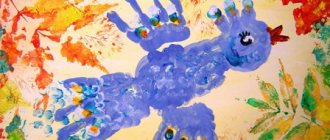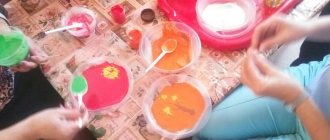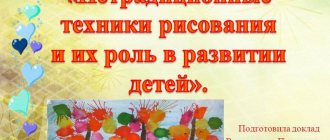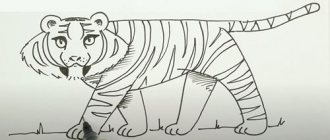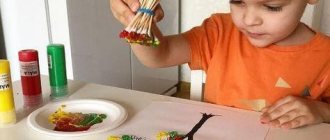Progress of the lesson.
We wind the yarn onto a rectangular piece of cardboard, then cut it off from one edge. Place the yarn on the edge of the green paper and coat it with glue. Roll it together with the paper into a tube.
The kids really enjoyed these activities. They became emotionally liberated. They felt comfortable and happy. They especially liked that the teacher gave them the opportunity to work independently. Emphasizing that they are already adults.
I believe that such activities are of great benefit. They can be done by older and even middle school children.
Short-term project in the senior group “Magic and Colors”
Children finish drawing bubbles. As the drawing progresses, guiding questions are asked, if necessary.
- Reflection.
Game “Good - Bad” (TRIZ)
Additional education teacher:
Guys, tell me, what's good about bubbles?
Children:
They are beautiful, you can play with them, they make us happy.
Additional education teacher:
What's wrong with bubbles?
Children:
They burst and can get into your eyes and sting.
Additional education teacher:
Well done, you know everything!
Additional education teacher:
So you and I have achieved real magic, a real miracle.
-Let's see who did what they did (works are being examined, the additional education teacher praises the children for their invention and resourcefulness).
-Guys, did you like drawing with bubbles?
-What was the most difficult thing for you?
-What's easy?
Children share their impressions.
Guys, you also drew bubbles today and I suggest finishing them in the group and organizing an exhibition of works called “The Tale of Soap Bubbles”
Consultation for parents
«
Drawing in unconventional ways"
The development of the creative potential of an individual should be carried out from early childhood, when a child, under the guidance of adults, begins to master various types of activities, including artistic ones. Great opportunities for the development of creativity lie in visual arts and, above all, drawing. Drawing is an important means of aesthetic education: it allows children to express their ideas about the world around them, develops fantasy and imagination, and makes it possible to consolidate knowledge about color and shape. In the process of drawing, the child improves his powers of observation, aesthetic perception, aesthetic emotions, artistic taste, creative abilities, and the ability to independently create something beautiful using accessible means. Drawing classes develop the ability to see beauty in the surrounding life, in works of art. Own artistic activity helps children gradually approach an understanding of works of painting, graphics, sculpture, and decorative and applied art. The image in the drawings is created using a variety of materials. Artists use various materials in their work: various chalks, paints, charcoal, sanguine, pastels and much more. And in children's creativity it is also necessary to include different paints (gouache, watercolor), ink, crayons, and teach children to use these visual materials in relation to their means of expression. Experience shows that drawing with unusual materials and original techniques allows children to experience unforgettable positive emotions. Emotions, as we know, are both a process and a result of practical activity, primarily artistic creativity. By emotions one can judge what pleases, interests, depresses, worries the child at the moment, what characterizes his essence, character, and individuality. Preschoolers, by nature, are able to sympathize with a literary hero, to play out various emotional states in a complex role-playing game, but to understand what beauty is and learn to express oneself in visual activity is a gift that one can only dream of, but it can also be taught. We adults need to develop a sense of beauty in a child. It depends on us how rich or poor his spiritual life will be. It should be remembered: if the perception of beauty is not supported by the child’s participation in the creation of beauty, then, as they say, “infantile enthusiasm” is formed in the child. In order to instill a love of fine art and arouse interest in drawing starting from early preschool age, it is necessary to use non-traditional methods of depiction. Such unconventional drawing gives children a lot of positive emotions, reveals the possibility of using objects well known to them as artistic materials, and surprises them with their unpredictability. Unusual methods of drawing captivate children so much that, figuratively speaking, a real flame of creativity flares up in the group, which ends with an exhibition of children's drawings. What non-traditional painting methods can you use at home? Blotography, salt painting, finger painting. Soap bubbles, splashing, etc. Wouldn't you like to know what happens when you draw with a rag or crumpled paper? You can draw however you want and with anything! Lying on the floor, under a table, on a table... On a leaf of a tree, on a newspaper... The variety of materials poses new challenges and forces you to come up with something all the time. And from the scribbles and scribbles, a recognizable object eventually emerges - the Self. The uncomplicated joy of satisfaction from the fact that “I did this - it’s all mine!” Having learned to express his feelings on paper, the child begins to better understand the feelings of others, learns to overcome shyness, fear of drawing, of the fact that nothing will work out. He is confident that it will work out, and it will turn out beautifully. Mastering various materials, ways of working with them, and understanding their expressiveness allows children to use them more effectively when reflecting their impressions of the life around them in drawings. The variety of visual materials makes visual activity more attractive and interesting, and as children master different materials, they develop their own style of depiction. One of children's favorite ways to draw unconventionally is painting with salt. It not only has interesting decorative capabilities, but is also very easy to use. Children love to draw and...with soap bubbles. You can draw using the blowing method. But you can draw with a toothbrush, cotton wool, your finger, your palm, a tampon, crumpled paper, a tube driving paint (a drop) across a sheet of paper, print with different objects, create compositions with a candle, lipstick, feet... Go ahead, get creative! And joy will come to you - the joy of creativity, surprise and unity with your children. Drawing art has a variety of techniques and they should be used when working with children. The use of various materials enriches children with knowledge of how to work with them, their visual capabilities, will make children's drawings more interesting, and will increase the aesthetic side of the drawing.
MAGAZINE Preschooler.RF
Municipal budgetary preschool educational institution Kvarken kindergarten No. 1 “Spikelet” Educator: Alfiya Baryevna Tarasova, 1st qualification category for the position of “educator” 2012-2013. Talents are difficult to recognize, not everyone can believe in them. Talents must be nurturedThey must be developed and believed in. Anyone who is understanding can recognize a simple truth: Talents can be nurtured by a Mentor if he is talented!!! Theoretical justification of the project Recently, there has been a sharp increase in interest in the problem of giftedness in children. And this is no coincidence. The ongoing changes in the system of preschool education and upbringing: a focus on the humanization of all pedagogical work, creating conditions for the development of the individuality of each child - make it possible to solve the problem of giftedness in preschool children in a new way and open up new aspects of its study. What is giftedness? A rare individual gift or a social reality?
A gifted child is a child who stands out for his bright, obvious, sometimes outstanding achievements (or has internal prerequisites for such achievements) in one or another type of activity, including those of a spontaneous, amateur nature.
There are two forms of manifestation of giftedness: 1) Obvious giftedness (reveals itself in the child’s activities quite brightly and clearly, including under unfavorable conditions; the child’s achievements are obvious). 2) Hidden talent (manifests in a disguised form). The reasons for a child’s hidden giftedness lie in the mistakes made by adults during his upbringing and development, in the peculiarities of his interaction with people around him, in the specifics of the cultural environment (mastering norms of behavior). Let us note the types of activities in which talent is manifested. — In practical activities (talented in crafts, sports and organizational). — In theoretical (cognitive) activity (intellectual talent of various types depending on the subject content of the activity (in the field of natural and human sciences, intellectual games, etc.)). — In artistic and aesthetic activities (choreographic, literary and poetic, visual and musical). — In communicative activities (leadership talent, characterized by the ability to understand other people, build constructive relationships with them, and lead). — In spiritual-value activity (giftedness, which is manifested in the creation of new spiritual values and serving people). Let us dwell on the problem and methodology of working with children's artistic talent, namely visual talent. Artistic abilities reveal themselves before others. Children are gifted in all types of art, but they received the most lasting recognition in art, and it is not surprising, because the product of their activity - drawings - can be stored, exhibited, studied as evidence of the talent of the little author. Regarding artistic creativity, a significant role is played by psychological mechanisms, such as age characteristics, emotional mood, needs, motivation, individual characteristics, and personal characteristics of the child. The combination of two functions in an artistic image - image and expression - gives the activity an artistic and creative character, determines the specifics of the indicative and executive actions of the activity. Consequently, it also determines the specificity of abilities for a given type of activity. Relevance A gifted child is a child who stands out for bright, obvious, sometimes outstanding achievements (or has internal prerequisites for such achievements) in a particular type of activity. Among the most interesting and mysterious natural phenomena, children's talent occupies one of the leading places. The problems of its diagnosis and development have concerned educators for many centuries. Interest in it is currently very high. This is explained by social needs and, above all, the need of society for an extraordinary creative personality. The uncertainty of the modern environment requires not only high human activity, but also his skills, the ability to think outside the box and behave. After all, it is highly gifted people who are able to make their greatest contribution to the development of society. Currently, we can talk about the development of various forms and assistance offered to children with increased abilities. However, it is also obvious that working with gifted children requires in-depth study and elaboration of its methodological foundations. In this regard, a preschool educational institution needs a project that will help maximize the potential of gifted children, including improving the system for identifying gifted children from an early age, development, providing targeted support to each child who has demonstrated extraordinary abilities, developing individual “educational routes” taking into account the specifics creative and intellectual talent of the child, formation of personal and professional self-determination. Assessing a child as gifted is not an end in itself. Identification of gifted children is necessary to set adequate goals for their education and upbringing, as well as to provide them with psychological assistance and support. Organization of circle work with gifted children in preschool educational institutions: The content of the process of working with children is determined by the Program “Identification and development of intellectual and creative personality in a preschool institution”
Club work promotes the integrity of the educational process and the further development of mental and creative talent.
Working with gifted children includes flexible content and pedagogical technologies that ensure the development of abilities taking into account the interests and inclinations of children. A subject-development environment stimulates mental and creative development.
Provides additional types of classes in accordance with the program for the development of gifted children and the child’s individual inclinations. Type of project: According to the dominant activity in the project: creative and exploratory. Content: social and pedagogical. By the nature of contacts: within the preschool educational institution.
Participants: Children of the middle group of the MBDOU "Kvarken kindergarten", parents, teachers.
Timing: By time: long-term (September-May) Work is carried out outside of class in the afternoon, 1 time per week. Lesson duration is 20 minutes.
Goal: Creating conditions for each child to demonstrate their creative abilities and interests, developing cognitive interest, providing the opportunity for creative self-realization of the individual in various types of activities.
Objectives: Identification of gifted children using various diagnostics; Using a differentiated approach to children when working with children, taking into account their individual characteristics; Using various forms and methods of work; Organization of various club activities; Involving parents in working with gifted children and establishing close cooperation with them.
Hypothesis: if the educational process in a preschool educational institution is organized taking into account the identification and development of gifted children in the context of the implementation of an individual development trajectory, provides opportunities for creative activity and personal self-realization, then high results will be achieved in the creative development of children, their successful adaptation and learning At school.
Object: children of the middle group of the municipal budgetary preschool educational institution "Kolosok"
Subject: expressed abilities of preschool children in various types of activities.
Forms and methods: - Creative associations of children, clubs - Project activities - Experimental research activities - Exhibitions, competitions, mini-Olympiads - Creative reports. Presentations
Basic principles of organizing work with gifted children: - Education at a higher level of difficulty - Creation of an enriched subject and educational environment, - conducive to the development of the child’s giftedness - Individualization and differentiation of learning - Psychological and pedagogical support for the child - Use of new educational technologies
Requirements for a teacher:
-High level of professional training for working according to the program -Teacher’s inclination towards creative activity -Ability to provide optimal development conditions for all children in the group -Presence of cooperation tactics in communication between the teacher and the child -Personal readiness to work with gifted children -Teacher has special abilities and skills, allowing him to interest children in the process of the activity he himself performs
Expected results: After the implementation of this Project, we expect to receive the following results: - improvement of forms of work with gifted and capable children; -creating conditions for the targeted identification, support and development of gifted children, their self-realization, professional self-determination in accordance with their abilities; -providing every child with equal starting opportunities in realizing their interests; stimulating motivation for developing abilities; - holding competitions and events at the district level; an increase in the number of children actively involved in creative and intellectual activities; -creation and testing of psychological and pedagogical diagnostics for identifying gifted children (psychological profile of a gifted child); -development of methodological recommendations for working with gifted children; -development of the prerequisites for creative productive thinking - abstract imagination, figurative memory, associative thinking, thinking by analogy.
The topic of the project is technology:
Development of creative abilities of children of senior preschool age in the process of drawing with non-traditional techniques and painting materials. Goal: Identification and development of creative abilities in children of the older group through entertaining painting activities. Objectives: 1) Study of the artistic abilities of older children in art activities. 2) Development of ways to develop creative abilities in the field of drawing with painting materials. 3) Testing non-traditional drawing techniques to develop the creative abilities of children of senior preschool age. Stage I – preparatory. Goal: 1) Creation of a development environment and appropriate material base. 2) Involve parents in the educational process in preschool educational institutions for the effective development of children’s creative abilities. 3) Based on the diagnostic results, prepare children for further work through a system of games, exercises, etc.
Creation of a developmental environment. Creating a nurturing environment is of great importance for successful learning to draw. When creating a developmental environment in the group, we relied on a number of principles: The principle of distance and rapprochement of positions in communication between an adult and a child in order to establish contact; The room and arrangement of furniture should be such as to satisfy the child’s possible desire for privacy during the creative process. The principle of stimulating activity and independent creativity. Children should not only have free access to tools and materials, but also the right to choose methods and themes for drawing. The principle of stability is the dynamism of the developing environment, which should be carried out in a reasonable change and enrichment of subject content, its rational content, allowing the implementation of plans at any time and, if possible, in different environments. Children can change this environment at their own discretion if their mood and desire require it.
In the Fine Art corner there is a sufficient amount of paper of different colors, textures and shapes; colored pencils, felt-tip pens, wax crayons, paints (gouache and watercolor), thin and thick brushes, pieces of cardboard, threads and strings of various thicknesses, seals and templates, water jars, napkins, palettes. All of the above is stored in separate boxes. New visual material is introduced gradually as preschoolers become familiar with it in class. The drawing corner also contains folders with reproductions of artists’ paintings, subject and subject drawings, postcards, and illustrations for fairy tales. stories. There is a separate folder with samples of drawings made using non-traditional image techniques; technological maps for applique, modeling and drawing. There are children's drawings on a special stand. The group has a tape recorder and recordings of music for the use of musical works in art classes. There are also easels, the child can move them to any place. The cabinets are freely accessible.
Forms of interaction with parents. Contents of the activity Deadlines 1. Joint excursion with children and parents to the forest. (Prepare material for non-traditional drawing techniques - leaves, twigs, pine cones, moss, etc.) 2. Questionnaire on the topic: “How do you feel about the manifestation of creative abilities in children.” 3. Exhibition “Gifts of Autumn” - crafts made from natural materials, vegetables, flower arrangements. September 1. Meeting on the topic: “Development of creative abilities of older children in the process of drawing with non-traditional techniques and painting materials.” 2. Workshop “Creating without a brush” - to introduce parents to photocopying techniques - drawing candles, blotography with a tube, drawing with thread, etc. October 1. Design a folding folder on the topic: “Tips for parents on working with paint.” 2. Open art activity session for parents. November 1. Competition for the best New Year's toy using non-traditional techniques. December (Appendix No. 1) 1. Advice for parents “To the museum with a child.” 2. Excursion of children with parents to the Museum of Fine Arts. January 1. Consultation for parents “How to organize home drawing and modeling classes.” 2. Photo exhibition “Corner of creative activities in the family.” February • Recommendations for parents “Recipes for making salted play dough.” • “Create and make your family’s coat of arms” - use salt dough, plasticine. March 1. Joint drawing lesson using non-traditional techniques. 2. Collage “My Favorite Fairy Tale” - use of postcards, candy wrappers, appliqué, origami, drawing, etc. (Joint work of parents and children). April 1. Exhibition of children's drawings using non-traditional techniques for parents. 2. Drawing festival with the participation of parents. May
Diagnostics of mastery of non-traditional drawing techniques. Levels of development Qualitative characteristics High level 2 points On his own initiative, in accordance with the plan, uses non-traditional drawing techniques (NTR). Experiments with fine and non-traditional materials to create an artistic image. Average level 1 point NTR uses fragments, most often after prompting from the teacher. Experiments with materials mainly at the suggestion of the teacher. Low level 0 points NTR uses only under the guidance of a teacher. Does not know how and does not want to experiment with isomaterials to create an artistic image. Conclusion: analysis of the diagnostic results allows us to draw a conclusion about the effectiveness of mastering non-traditional drawing techniques and organizing the educational process in a kindergarten group. The degree of progress of preschool children in mastering program material is traced. Didactic games and exercises used in working with children to develop their creativity and imagination. "Which! Which! Which!" Children stand in a circle and pass some natural object from hand to hand. Having become acquainted with it, the child must express his feelings in words. Moving in a circle, the natural object gradually reveals its new facets to us. For example, an acorn is oval, smooth, hard, etc. “What does it look like.” Children pass a natural object around in a circle, comparing it with other familiar objects. For example, a spikelet - on a tree, bird feathers, a panicle, a pigtail, a tail, etc. “Assemble a pattern.” The teacher invites children to individually lay out on paper circles or strips a pattern of flat natural shapes - pumpkin seeds, watermelon, melon, etc. The technique of alternating natural materials that are contrasting in shape and color is used. "Transformer." The teacher invites the children, using various natural materials, to lay out any familiar image on a sheet of paper, and then use the same details to create a completely different image. Magazine "Preschool Education N 10, 2005" "Pebbles on the shore." Goal: to teach children to create new patterns based on the perception of schematic images. Material: a large picture depicting a seashore, several pebbles (5 – 7) of different shapes (each stone resembles some object, animal or person). Progress of the game: an adult shows the children a picture and says: “A wizard walked along this shore and turned everything in his path into pebbles. You have to guess what was on the shore and come up with a story about each pebble. What it is? How did he end up on the shore? Etc." "Cheerful gnome." Goal: to teach children to create images based on the perception of a schematic image of an object. Material: a picture depicting a gnome with a bag in his hands and several bags of different shapes cut out of paper, which can be superimposed on the picture and changed in the gnome’s hands. Progress of the game: an adult shows the children a picture and says that a gnome has come to visit the children; He brought gifts, but the children must guess for themselves. Make up a story about one of the gifts and about the child who received it. "What does it look like". Goal: to teach children to create images of objects in their imagination, based on their schematic representation. Material: set of 10 cards; Each card has one figure drawn on it, which can be perceived as a detail or an outline image of a separate object. Progress of the game: an adult shows a picture from the set and asks what it looks like. It is important to support children's initiative and emphasize that each child must give his own original answer. "Wonderful forest" Goal: to teach children to create situations in their imagination based on their schematic representation. Material: identical sheets of paper on which several trees are drawn and unfinished, unformed images are located in different places. Sets of colored pencils. Progress of the game: an adult gives the children sheets of paper and invites them to draw a forest full of wonders, and then tell a story about it. "Shifters." Goal: to teach children to create images of objects in their imagination based on the perception of schematic images of individual parts of these objects. Material: Pencils, sets of 8 – 16 cards. Each image is positioned in such a way that there is free space left for finishing the picture. Progress of the game: the adult invites the children to draw whatever they want to the figurine, but so that it turns out to be a picture. Then you need to take another card with the same figure, put it upside down or sideways and turn the figure into another picture. When the children complete the task, take cards with another figure. "Magic Pictures" Goal: to teach children to imagine objects and situations based on schematic images of individual parts of objects. Material: pencils, sets of 7 cards. Each card contains a schematic representation of a detail of an object or geometric figure. Each image is positioned in such a way that there is free space left for finishing the picture. Progress of the game: The teacher explains the content of the game: children can turn each figure depicted on the card into any picture they want. Then he selects non-repeating pictures and draws the children’s attention to them. O. M. Dyachenko “Development of the preschooler’s imagination.” Stage II is the main one. Goal: development of artistic and creative abilities in children of senior preschool age with the help of non-traditional techniques and painting materials through a system of classes. During the classes, the following methods and techniques are used: conversation, demonstration of technical techniques. Explanation, instruction, reminder, encouragement, analysis, game methods. The classes use non-traditional equipment, illustrative material, and music.
| Next > |
